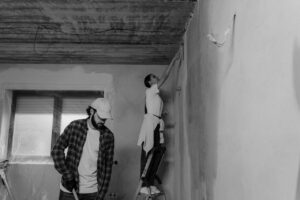Considering rendering yourself at home? In Melbourne, homeowners often question themselves – should we DIY or hire a pro to render our property? People often chat about rendering yourself on homeone. For jobs such as two small walls in a courtyard.
Task the very best offering for Rendering in Melbourne from Australian Rendering Company. If you are considering a DIY rendering project, consider both your ability and what the project requires. It may save money to do it yourself, but be mindful of the size and complexity of the project.
Got a question or have a rendering project to discuss? Call Australian Rendering Company at 0466 943 872, or email to contact@australianrenderingcompany.com.au. Choosing the right one for your project’s needs is key to the best results.

Rendering: What to Know
For a strong, handsome finish, you should speak the language of rendering. Rendering is crucial to construction and renovation of homes. It improves the strength of brickwork, keeps buildings warm, and ensures they look good.
What is Rendering?
RENDER is something that goes on the exterior of a building. It strengthens the brickwork, keeps the building warmer and makes it look better. It’s necessary for keeping buildings safe from the weather and looking their best.
Rendering isn’t just a matter of appearance; it’s about preserving the building. It shields the building from the elements and extends its life. Australian Rendering Company provides different types of rendering services such as acrylic and cement to suit all those needs.
Types of rendering in Australia
Rendering There are many different types of rendering in Australia and each rendering has its own unique qualities. What kind of rendering you get depends on what you want, such as the appearance you want, how long you want it to last and the weather.
Acrylic Rendering
In a nutshell, the popularity of acrylic rendering lies in its flexibility and an ability to resist cracking. It works on a wide variety of surfaces and in an array of climates. Acrylic render is wonderful in that it has the ability to move with the house without cracking.
Cement Rendering
Cement render is the original choice and it has longevity, classic appeal. It is typically used outdoors because it is strong and can withstand the elements. Render The Auckland service is widespread and can be used on a broad range of buildings and surfaces.
Other Rendering Options
You can also explore other alternatives such as silicone and lime rendering. These have special attributes, such as superior water resistance and greater breathability. They cater to particular needs and preferences.
Can I Do Rendering Myself? Evaluating Your Skillset and Your Project
Before embarking on a DIY rendering project, it’s important to assess your skill level as well as the needs of the project. Rendering is hard, particularly for beginners. It requires a little know-how and some experience.
What Do You Need to Render a House Yourself?
To do a DIY rendering job properly, you need a few basic skills. These are, being a good mason and render. If you’ve done similar projects or worked with rendering materials — that helps a lot. Just in case you forgot, rendering these things is hard.
Do It Yourself Projects Homeowners Can Tackle
For their part, do-it-yourselfers can take on small, straightforward rendering projects. You know, like when you fix a little wall or a piece of garden sculpture. These require less stuff and effort, making them suitable for beginners. Thus simple, easy, doable projects that lend themselves very well to learning and improving on crafting skills.
The Ultimate Rendering Masters
There are some things a beginner shouldn’t try to tackle with their rendering, or at the very least, might be better to leave to a pro.
Those big or complex rendering jobs are best left to the pros. They have the skills and the stuff for hard jobs. Too, jobs requiring special expertise, such as repairing old buildings, should be left to the experts.
You can determine whether DIY is for you by taking a look at your skills and what this project calls for. Or if you should get a pro. This decision is crucial to a satisfying result and quality in your rendering.
Necessary tools and materials rendering do it yourself (DIY)
To get a DIY rendering job right, you need the perfect tools and materials. Experts say the key is to prepare the wall and mix materials properly. Baumit also emphasizes the need to specify the correct render for the conditions you’re looking at.
Essentials for Rendering Jobs
For a homemade rendering job, you will need a few tools. These items are a trowel, mixing bucket, mixing drill and a hawk. Decent quality tools make it easier and give you a better finish. There’s also a spirit level to make sure the render is spread flat.
Picking the Best Rendering Material for Australian Conditions
The climate in Australia varies, so it is important to choose the right materials. In spots where the weather is brutal, it’s vital that your furniture is durable and weather resistant. Cement-based renders are very strong and long-lasting, but lime or acrylic might be more suitable for some jobs.
Consider the substrate, weather exposure and finish you desire when choosing materials. Consider discussing your project with suppliers or experts to get a sense of what the best materials might be for your project.
DIY How to Render Steps
326028844826162 For a quality DIY rendering job, you need to prepare well and use the correct techniques. Do this process step by step after preparing the surface. This will make you look professional.
Getting Your Surface Ready
First, ensure the surface is clean, dry, and dust free. Look the wall over for cracks, breaks and, if they’re there, fill them. The surface must be level and firm so that the render will adhere well.
For brick or block, rake out loose material and old render. If it is very porous, apply a bonding agent to get the render to stick better.
Blending Render Accurately with Other Uses
“For the final finish and to achieve the appropriate strength and color, you want to get the render mix right. Follow the instructions from the manufacturer for the right amount of water to render ratio. Too wet and they may shrink, too dry and they may not stick.
For outdoor use, you’ll want a tougher blend to withstand the elements. Because inside, a finer blend creates a smoother appearance.
How to Apply and Use it
Begin with a scratch coat for surface preparation. Apply the render with a trowel, keeping the trowel on a slight angle to prevent air bubbles. A rendering float is good for large areas — it will help you get an even finish.
work from the bottom up so as not to drip down. Let each coat dry before applying the next, based on the recommended drying times.
Don’t Make These Common DIY Rendering Mistakes
Do not stint on surface preparation; it impacts adhesion and finishes. And don’t feed in bad weather, such as extreme heat or rain.
Avoid overworking the render otherwise you end up with a very smooth and brittle texture. This can harm the surface.
Australian Climate Finishing and Curing
Shield the render from Australia’s finicky weather while it is curing. Keep it moist with water, especially in hot and dry conditions, so it won’t crack.
When it’s cooler outside, or the humidity is up, open a window, making sure the space is well-ventilated so it won’t get moldy. After it sets up completely, apply a finish coat and follow the manufacturer’s recommendation to finish it off the best way you can.
When to Call in the Pros: Choosing for Your Rendering Project
You can save a chunk of change with do-it-yourself rendering on a small job. But for large or complicated jobs, you should probably call in the pros. They have the expertise and resources required.
DIY can result in problems like uneven finishes for Homeone homeowners. But, experts can weather the elements and ensure a product of quality.
Consider the size of your project, your capabilities and the risks in making a choice. DIY is great if you’re confident that you can do a good job. But if you’re not sure, just ask for help.
Selecting the correct option for you project requires careful consideration. Consider the price benefits of DIY versus professional assistance to achieve the best result for your budget.
Can I render myself or do I need to get someone in?
Ahead, we explain whether you should render on your own or turn to a professional, based on your current skill set and personal experience. As long as you are handy enough, rendering as a DIYer can save you money. But for large or complex jobs, it is best to bring in a professional.
What types of rendering are there in Australia?
Then, there is acrylic, cement, and monocouche rendering for use in Australia. Both have been beneficial. Acrylic is resistant and flexible, while cement delivers a hardy finish.
What skills and experience do you need for a DIY render?
To attempt a DIY rendering job you must either be experienced and skilled in preparing and applying render. You also need to consider what your project is and where you are in Australia.
Do it yourself rendering, what do you need?
For DIY rendering, you’ll want tools such as trowels and floats, materials such as render mix and sand. It is critical to select materials that have good outcomes for use in Australia and to follow the instructions of the manufacturer.
How should I get my surface ready for rendering?
Once your surface is ready, clean it off, patch up any holes, and be sure the surface is dry and free of dust. You also may have to use a bonding agent or a render coat.
What are some common DIY rendering errors to avoid?
Common errors are in inadequate preparation of the surface and rendering in adverse weather. You can steer clear of them: Follow the manufacturer’s instructions Scrub in plenty of time And be prepared for a change in the weather.
How do a render a professional job rendering myself?
It’s all about using the correct techniques and tools to achieve a professional finish. Use render in slender layers and add techniques such as sponging or trowelling. Be sure to cure the render properly and keep it out of the elements.
Is DIY rendering cheaper than getting a pro in?
Those interested in DIY rendering might be able to save some money provided they have the necessary talent. But for larger or more complex projects, hiring a professional could be more cost-efficient. They can guarantee a good finish, and prevent errors.
What is the value in hiring a professional for my rendering job?
With the help of a professional, you are guaranteed of a smooth finish without errors. Professionals have the expertise, experience and tools to get the job done well and do quickly. They also stand behind their work with warranties or guarantees.




